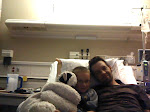What Is a Drug Pump?
 SynchroMed II Drug Pump
SynchroMed II Drug PumpAbout the Drug Delivery System
The system consists of a pump and catheter, both of which are surgically placed under the skin. The pump is a round device that stores and delivers pain medication. It is placed in your abdomen. The catheter (a thin, flexible tube) is inserted into your spine and connected to the pump.During the surgery, your doctor fills the pump with pain medication using a needle. The pump sends the medication through the catheter to the spinal area where pain receptors are located. You return to your doctor for more medicine when the pump needs to be refilled.
How It Works
The spinal cord is like a highway for pain signals that are heading to the brain. When the pump sends pain medication directly to the spine, it interrupts the pain signals before they reach the brain.Medtronic Products
Drug delivery therapy from Medtronic may help manage your cancer pain so you are more comfortable and able to perform your usual daily activities, although it may not be possible to eliminate your pain completely.The Medtronic SynchroMed® drug delivery system consists of:
- A battery-operated pump surgically placed under the skin of the abdomen
- A soft tube called a catheter, surgically placed under the skin, that carries the medication from the pump to the intrathecal space of the spine
- A handheld programmer your clinician uses to adjust the medication dosage to treat your pain
- A handheld patient control device called myPTM® that allows you to give yourself an extra dose of medication (within physician-set parameters) in response to intermittent pain (ask your clinician if this device is appropriate for your condition and if it is covered by your insurance)
It is important to note that the system can be surgically removed if you decide to discontinue the therapy.

